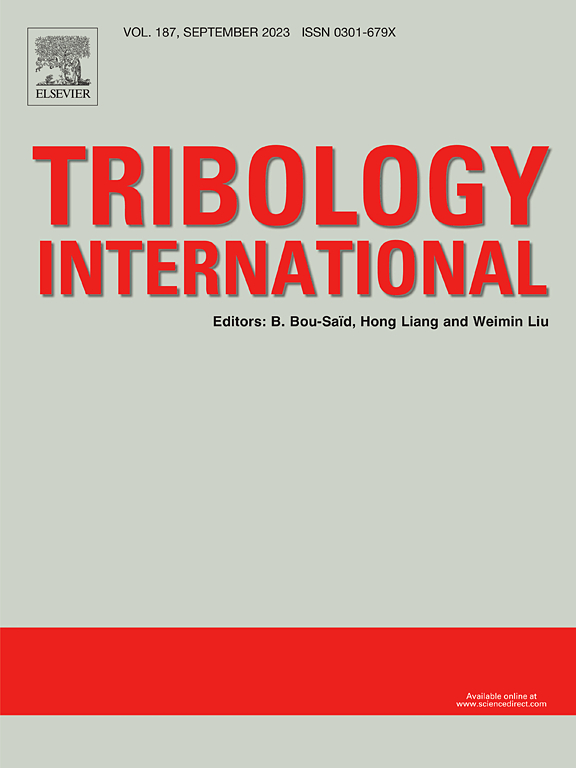A compact tribometer setup for in-situ investigation of tribological contacts using X-ray diffraction
IF 6.1
1区 工程技术
Q1 ENGINEERING, MECHANICAL
引用次数: 0
Abstract
In triboexperiments, structural and chemical changes in a material that lead to wear and, subsequently, component failure, are usually investigated ex post, when wear patterns are already fully formed. Therefore, time-resolved in-situ analysis is crucial for an in-depth investigation of the evolution of these wear patterns to reveal the underlying mechanisms in the tribocontact that entail to material damage and failure.
This paper introduces a compact tribometer setup especially designed for operation inside a standard-sized diffractometer for both, laboratory and synchrotron applications. This setup enables the in-situ investigation of friction-induced wear mechanisms, such as material transfer, structural changes and surface layer formation using X-ray diffraction (XRD) analysis at specific points in time and space during the experiment without the necessity of sample transfer, which were complementarily compared to electron backscatter diffraction (EBSD) measurements.
First results obtained at the KMC-2 beamline at BESSY II are presented and compared to laboratory measurements of the same tribosystems. Steel on Ti experiments revealed a change in the preferential orientation of the Ti crystallites induced by a sliding steel pin immediately after a few cycles. In experiments with Al-on-Ti and brass-on-Cu configurations, a transfer of the softer pin material to the harder sample surface and the subsequent formation of a mixed oxide layer were observed.
The presented setup provides a versatile tool for the in-situ investigation of dynamic near-surface changes in tribosystems with a wide range of applications, including material transfer, surface layer formation, structural changes as well as the evolution of residual stresses.

一种紧凑的摩擦计装置,用于使用x射线衍射进行摩擦接触的原位研究
在摩擦实验中,材料的结构和化学变化导致磨损和随后的部件失效,通常在磨损模式已经完全形成时进行事后研究。因此,时间分辨原位分析对于深入研究这些磨损模式的演变至关重要,可以揭示摩擦接触导致材料损伤和失效的潜在机制。本文介绍了一种紧凑的摩擦计装置,专为在标准尺寸的衍射仪内操作而设计,用于实验室和同步加速器应用。该装置可以在实验过程中使用x射线衍射(XRD)分析特定时间和空间点的摩擦磨损机制,如材料转移、结构变化和表面层形成,而无需进行样品转移,这与电子背散射衍射(EBSD)测量相补充。介绍了在BESSY II的KMC-2光束线上获得的初步结果,并将其与相同摩擦系统的实验室测量结果进行了比较。钢在Ti上的实验表明,滑动钢销在几个循环后立即引起Ti晶的优先取向变化。在Al-on-Ti和黄铜-on- cu结构的实验中,观察到较软的引脚材料转移到较硬的样品表面,并随后形成混合氧化层。该装置为摩擦系统近表面动态变化的原位研究提供了一种多功能工具,具有广泛的应用,包括材料传递,表面层形成,结构变化以及残余应力的演变。
本文章由计算机程序翻译,如有差异,请以英文原文为准。
求助全文
约1分钟内获得全文
求助全文
来源期刊

Tribology International
工程技术-工程:机械
CiteScore
10.10
自引率
16.10%
发文量
627
审稿时长
35 days
期刊介绍:
Tribology is the science of rubbing surfaces and contributes to every facet of our everyday life, from live cell friction to engine lubrication and seismology. As such tribology is truly multidisciplinary and this extraordinary breadth of scientific interest is reflected in the scope of Tribology International.
Tribology International seeks to publish original research papers of the highest scientific quality to provide an archival resource for scientists from all backgrounds. Written contributions are invited reporting experimental and modelling studies both in established areas of tribology and emerging fields. Scientific topics include the physics or chemistry of tribo-surfaces, bio-tribology, surface engineering and materials, contact mechanics, nano-tribology, lubricants and hydrodynamic lubrication.
 求助内容:
求助内容: 应助结果提醒方式:
应助结果提醒方式:


